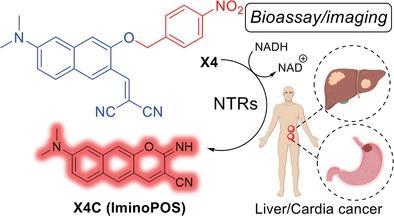当前位置:
X-MOL 学术
›
Adv. Healthcare Mater.
›
论文详情
Our official English website, www.x-mol.net, welcomes your
feedback! (Note: you will need to create a separate account there.)
Two-Photon Small-Molecule Fluorogenic Probes for Visualizing Endogenous Nitroreductase Activities from Tumor Tissues of a Cancer Patient
Advanced Healthcare Materials ( IF 10.0 ) Pub Date : 2022-04-29 , DOI: 10.1002/adhm.202200400 Changmin Yu 1, 2 , Shuangxi Wang 1 , Chenchen Xu 1 , Yang Ding 1 , Gaobin Zhang 1 , Naidi Yang 1 , Qiong Wu 1 , Qicai Xiao 3, 4 , Limin Wang 5 , Bin Fang 5 , Chibin Pu 6 , Jingyan Ge 7 , Liqian Gao 4 , Lin Li 1, 5, 8 , Shao Q Yao 3
Advanced Healthcare Materials ( IF 10.0 ) Pub Date : 2022-04-29 , DOI: 10.1002/adhm.202200400 Changmin Yu 1, 2 , Shuangxi Wang 1 , Chenchen Xu 1 , Yang Ding 1 , Gaobin Zhang 1 , Naidi Yang 1 , Qiong Wu 1 , Qicai Xiao 3, 4 , Limin Wang 5 , Bin Fang 5 , Chibin Pu 6 , Jingyan Ge 7 , Liqian Gao 4 , Lin Li 1, 5, 8 , Shao Q Yao 3
Affiliation

|
Nitroreductase (NTR), a common enzymatic biomarker of hypoxia, is widely used to evaluate tumor microenvironments. To date, numerous optical probes have been reported for NTRs detection. Approaches capable of concisely guiding the probe design of NTRs suitable for deep-tissue imaging, however, are still lacking. As such, direct optical imaging of endogenous NTR activities from tumors derived from cancer patients is thus far not possible. Herein, aided by computational calculations, the authors have successfully developed a series of two-photon (TP) small-molecule fluorogenic probes capable of sensitively detecting general NTR activities from various biological samples; by optimizing the distance between the recognition moiety and the reactive site of NTRs from different sources, the authors have discovered and experimentally proven that X4 displays the best performance in both sensitivity and selectivity. Furthermore, X4 shows excellent TP excited fluorescence properties capable of directly monitoring/imaging endogenous NTR activities from live mammalian cells, growing zebrafish, and tumor-bearing mice. Finally, with an outstanding TP tissue-penetrating imaging property, X4 is used, for the first time, to successfully detect endogenous NTR activities from the liver lysates and cardia tissues of a cancer patient. The work may provide a universal strategy to design novel TP small-molecule enzymatic probes in future clinical applications.
中文翻译:

用于可视化癌症患者肿瘤组织内源性硝基还原酶活性的双光子小分子荧光探针
硝基还原酶 (NTR) 是一种常见的缺氧酶生物标志物,广泛用于评估肿瘤微环境。迄今为止,已经报道了许多用于 NTR 检测的光学探针。然而,仍然缺乏能够简明地指导适用于深部组织成像的 NTR 探针设计的方法。因此,迄今为止不可能对源自癌症患者的肿瘤的内源性 NTR 活性进行直接光学成像。在此,借助计算计算,作者成功开发了一系列双光子(TP)小分子荧光探针,能够灵敏地检测各种生物样品中的一般 NTR 活性;通过优化来自不同来源的 NTR 的识别部分和反应位点之间的距离,作者发现并通过实验证明了X4在灵敏度和选择性方面均表现出最佳性能。此外,X4显示出出色的 TP 激发荧光特性,能够直接监测/成像活哺乳动物细胞、生长斑马鱼和荷瘤小鼠的内源性 NTR 活性。最后,凭借出色的 TP 组织穿透成像特性,X4首次用于成功检测癌症患者肝脏裂解物和贲门组织的内源性 NTR 活性。该工作可能为在未来的临床应用中设计新型 TP 小分子酶探针提供通用策略。
更新日期:2022-04-29
中文翻译:

用于可视化癌症患者肿瘤组织内源性硝基还原酶活性的双光子小分子荧光探针
硝基还原酶 (NTR) 是一种常见的缺氧酶生物标志物,广泛用于评估肿瘤微环境。迄今为止,已经报道了许多用于 NTR 检测的光学探针。然而,仍然缺乏能够简明地指导适用于深部组织成像的 NTR 探针设计的方法。因此,迄今为止不可能对源自癌症患者的肿瘤的内源性 NTR 活性进行直接光学成像。在此,借助计算计算,作者成功开发了一系列双光子(TP)小分子荧光探针,能够灵敏地检测各种生物样品中的一般 NTR 活性;通过优化来自不同来源的 NTR 的识别部分和反应位点之间的距离,作者发现并通过实验证明了X4在灵敏度和选择性方面均表现出最佳性能。此外,X4显示出出色的 TP 激发荧光特性,能够直接监测/成像活哺乳动物细胞、生长斑马鱼和荷瘤小鼠的内源性 NTR 活性。最后,凭借出色的 TP 组织穿透成像特性,X4首次用于成功检测癌症患者肝脏裂解物和贲门组织的内源性 NTR 活性。该工作可能为在未来的临床应用中设计新型 TP 小分子酶探针提供通用策略。


















































 京公网安备 11010802027423号
京公网安备 11010802027423号